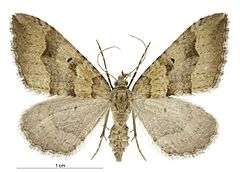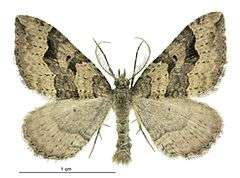Epyaxa rosearia
| New Zealand looper | |
|---|---|
 | |
| Female | |
 | |
| Male | |
| Scientific classification | |
| Kingdom: | Animalia |
| Phylum: | Arthropoda |
| Class: | Insecta |
| Order: | Lepidoptera |
| Family: | Geometridae |
| Genus: | Epyaxa |
| Species: | E. rosearia |
| Binomial name | |
| Epyaxa rosearia (Doubleday, 1843) | |
| Synonyms | |
| |
Epyaxa rosearia, the New Zealand looper, is a moth of the Geometridae family. It is endemic to New Zealand.
Taxonomy
E. rosearia was first described by Henry Doubleday in 1843 and named Cidaria rosearia.[1][2]
Description
The eggs of this species are pale yellow in colour and are oval in shape with a smooth shell.[3]
Alex Purdie describes the caterpillar of this species as:
Length, at rest, about three- quarters of an inch. Colour light-green, with indistinct whitish longitudinal lines, and a narrow median dorsal stripe of the ground colour, edged on each side by one of these whitish lines ; a subdorsal whitish line on each side of the median stripe; the ground colour shows again as a lateral line, edged below with whitish. Under-side with delicate whitish or yellowish longitudinal tracings, as on the upper side. The junctions of the segments show yellowish or whitish rings when the larva contracts. Head, greenish-yellow. Body tapering somewhat to the head.[3]
The caterpillars form a chrysalis that is glossy and very dark brownish-black in colour.[3] They can be found amongst the leaves of the forest floor.[4] E. rosearia adults are varied in appearance. They can have a pinkish tinge or can be brownish in hue although olive-green colouration is also common.[4]
Distribution
E. rosearia are very common throughout New Zealand.[4]
Host species
While it is endemic to New Zealand,[5] the larvae have so far only been recorded feeding on exotic plant species: Nasturtium officinale, Plantago lanceolata Trifolium ambiguum, Trifolium repens, Tropaeolum majus.[6] The larvae also seem to feed on the leaves of Trifolium caucasicum.
References
| Wikimedia Commons has media related to Epyaxa rosearia. |
- ↑ "Cidaria rosearia Doubleday, 1843". www.nzor.org.nz. Landcare Research New Zealand Ltd. Retrieved 2018-01-15.
- ↑ Dieffenbach, E. (1843). "List of Annulose Animals hitherto recorded as found in New Zealand with descriptions of some new species by Messrs. Adam White and Edward Doubleday.". Travels in New Zealand: with contributions to the geography, geology, botany and natural history of the country. 2. London: John Murray. p. 285.
- 1 2 3 Purdie, A. (1885). "Life History of Epyaxa rosearia, Dbld". Transactions and Proceedings of the New Zealand Institute. 18: 208–209 – via Biodiversity Heritage Library.
- 1 2 3 Hoare, Robert J. B. (2014). A photographic guide to moths & butterflies of New Zealand. Ball, Olivier. Auckland: New Holland Publishers (NZ) Ltd. p. 95. ISBN 9781869663995. OCLC 891672034.
- ↑ "Epyaxa rosearia (Doubleday, 1843)". www.nzor.org.nz. Landcare Research New Zealand Ltd. Retrieved 2018-01-14.
- ↑ "PlantSynz - Invertebrate herbivore biodiversity assessment tool: Database". plant-synz.landcareresearch.co.nz. Landcare Research New Zealand Ltd. 2011. Retrieved 2018-01-14.